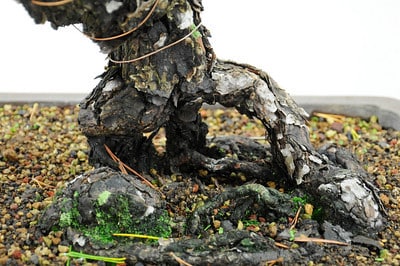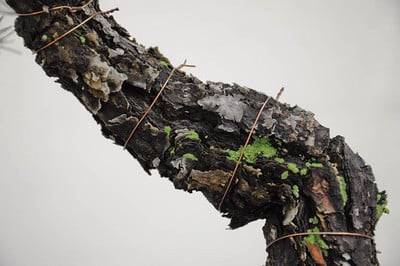The Japanese black pine pictured below hasn’t been re-styled in a long time. It’s healthy now, and ready for a change.
Currently, the foliage is heavy on both the left and right sides. The owner is hoping to emphasize one side over the other. The two outstanding questions: which front is the most effective? and in which direction should the tree flow – left or right?

Front #1

Front #2

Front #3
The tree’s biggest obstacle is found at the base of the trunk. The tree has three main roots that emerge from the trunk before they spread out into finer roots. This potting position makes it look like the tree is balancing on two legs and a tail. The new potting angle will very likely minimize this effect.

Base of the trunk from the front

Detail – base of the trunk
The tree’s greatest asset is its age. This is best appreciated in the flakey bark along the trunk. The small aluminum wires are keeping the plates in place – they will be removed when the tree is next shown.

Trunk detail – great bark

Trunk detail – bark
Any suggestions?
Subscribe to Bonsai Tonight
New Posts Delivered Every Tuesday and Friday
Graham says
I like front #3. The tree appears shorter than the other two fronts and this angle provides a more interesting view of the main branches on the left side.
Cheers Graham
Fr. Tom Davis says
I like the trunk movement in #2
Farhan says
Front #3 accentuates the trunk curves and would be my choice.
bonsaijapan says
I also like front #3. Although having said that it is hard to tell from a pictures. It will be interesting to see which front is chosen and how you plan to tackle the roots.
Joe
AlexV says
I am trying to remember the front I liked when we were looking at this tree, but i think it is somewhere on the back. Of the 3 shown, I like the second one. The third is good too, but i like the gentler curve of the second front. This is a really tall tree, and will make a nice bunjin once that huge mass of branches is trimmed down.
As for the roots, can’t you solve the problem by just burying it a bit deeper to hide the open root syndrome?
Alex
Michael M says
Photo #3 looks the best choise to me. There is more movement in the trunk, The flow of the tree is to the left. The lowest, longest branch is to the left and the top seems to be going left or could be moved in that direction. A little more drama from this angle.
Looking forward to the “after” picture.
Thanks
Michael
Natural Bonsai says
Hard to tell from the pictures, but I like No. 2 the best!
Andrew
Barry McDonnell says
I like front #1 the best for the following reasons: it gives you a better view of the tree’s trunk, which in #2 and #3 appears to have some inverse tappering; and with front #1, I think you will have better balance in the middle third of the tree
Dale Brock says
That is a hard fix. Repotting at a deeper depth would cover it up; but, I think I would consider finding an sharp angular stone that could be placed in between. It would essentual create a root over rock and would take some time for the roots to thicken and adhere to the rock but the s-shaped trunk could be placed as if it is reaching over the stone. Take some work to find the stone, but it would be worth it in the end.
Stavros says
I would go with option no.1 only because it somehow hides the inverse taper at the base of the trunk, a problem that becomes obvious with the other 2 possible fronts.